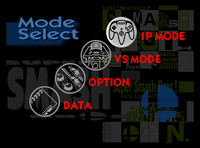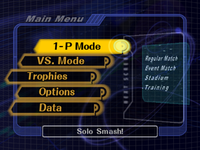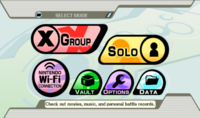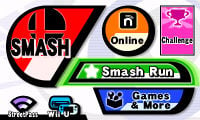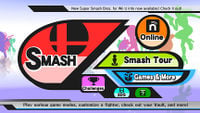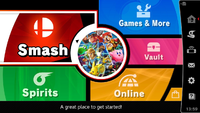Mode
- "Solo" redirects here. For the Hero of Dragon Quest IV who is one of Hero's alternate costumes, see Hero.
Modes (sometimes referred to as Main Menus) are various ways to play Super Smash Bros. games. The list below shows all the modes of each games and compares them.
Comparison
| Starter | Unlockable | Added via update | As part of another mode | No longer functions |
Notes
In Super Smash Bros.
1P Mode
VS Mode
- Handicap
- Team Attack
- Stage Select
- Damage
- Item Switch[1]
Option
Data
In Super Smash Bros. Melee
The * indicates that this mode must be unlocked.
1-P Mode
- Regular Match
Vs. Mode
Trophies
Options
Data
- Snapshots
- Archives (NTSC)
- Sound Test*
- How to Play (PAL)
- Melee Records
Only accessible via hacking
In Super Smash Bros. Brawl
The * indicates that this mode must be unlocked.
Solo
Group
Nintendo Wi-Fi
Options
Vault
Data
- Movies
- Records
- Group Records
- Brawl Records
- Notices
- Sound Test
In Super Smash Bros. 4
Smash
 Smash Run
Smash Run
 Smash Tour
Smash Tour
Games & More
- Classic Mode
- All-Star Mode
- Stadium
- Training Mode
 Events
Events Special Orders
Special Orders
- Custom
 Stage Builder
Stage Builder- amiibo (
 added in version 1.0.5 on New 3DS and version 1.0.8 on 3DS /
added in version 1.0.5 on New 3DS and version 1.0.8 on 3DS /  available at release)
available at release) - Vault
- Options
Online
- With Anyone
- With Friends
 Tourney (added in version 1.1.0)
Tourney (added in version 1.1.0)- Conquest (
 added in version 1.0.1 /
added in version 1.0.1 /  available at release)
available at release) - Spectate
- Share (
 added in version 1.0.5 /
added in version 1.0.5 /  available at release)
available at release)
Other modes
- Challenges
 StreetSmash
StreetSmash Wii U connect /
Wii U connect /  3DS connect
3DS connect
In Super Smash Bros. Ultimate
Smash
8-Player Smash is available as part of the regular Smash mode, and so it does not occupy a separate menu item as it did in Super Smash Bros. for Wii U.
Games & More
- Classic Mode
- Training
- Mob Smash
- Home-Run Contest (Added in version 5.0.0)
- Mii Fighters
- amiibo
- Stage Builder (Added in version 3.0.0)
- Challenger's Approach (only if there are fighters that must be unlocked and haven't been)
- VR (Added in version 3.1.0)
Online
- Smash
- Online Tourney (Added in version 4.0.0)
- Spectate
- Shared Content (Added in version 3.0.0)
Vault
- Sounds
- Replays
- Video Editor (Added in version 3.0.0)
- Records
- Challenges
- Tips
- Movies
- Shop
Spirits
- Adventure Mode
- Spirit Board
- Collection
- Rematch (Added in version 8.0.0)
- DLC Spirits (Added in version 3.0.0)
Dashboard
- Return to Top Menu
- Collection
- Local Wireless
- News
- Options
- Help
Other
- Sephiroth Challenge (Added in version 10.0.0) (Limited-time: removed in version 10.1.0)
In competitive play
Many modes across the Smash series have developed their own competitive communities over the years. The most popular mode by a wide margin is the Vs. Mode of each game, which forms the basis for each game's tournament scene. While the exact rules and structure vary between games and region, the basic outline involves at least two players picking a character and a legal stage and playing until one is declared the winner. 1v1 games (often refered to as "singles") are the most popular format, but other formats such as 2v2 (often refered to as "doubles"), Squad Strike, and occasionally free for all and Smashdown matches also take place. Games involving Special Smash have also developed a niche competitive scene, with specific rules and conditions gaining popularity in side events.
Single player modes have also developed their own unique communities. Most modes involve the acheiving or breaking of some kind of record. Since players do not directly compete with each other in this format, a leaderboard system is often used to track these records. Players will submit their gameplay to the leaderboard for review, where it will be determined if the gameplay is both legitimate and meets all established standards. If it passes, it goes onto the leaderboard. Games that track a high score like Home-Run Contest and Multi-Man Smash have active communities frequently developing new techniques and strategies to acheive the highest possible score. Modes with a clear end point like All-Star Mode, Classic Mode, Target Smash and Events also have communities that also develop new techniques and strategies to complete the modes in the least possible amount of time, often dubbed a speedrun.
Modes that can be played online have mostly the same rules as offline, though some differ slightly to account for the different environment. There are often penalties put in place in the event of internet connectivity issues, with contingency plans set up in the case of major catastrophes. Some communities require certain modes to be played offline with official hardware, as playing online often means using emulators and unverified hardware, which brings the possibility of inconsistent gameplay and cheating.
Trivia
- In the Japanese version of Melee, the Main Menu is instead named Top Menu. Additionally, it was originally going to be named Top Menu in English as well, but the final version of the game reverts the name back to Main Menu.
- Ultimate uses the name Top Menu in English, under the Dashboard's "Back to Top Menu" option.
Notes
| Super Smash Bros. menu items | |
|---|---|
| VS Mode | VS Start (Team Battle) · Rule · Time / Stock · VS Options |
| 1P Mode | 1P Game · Training Mode · Bonus 1 Practice · Bonus 2 Practice |
| Option | Sound · Screen Adjust · Backup Clear |
| Data | Characters · VS Record · Sound Test |
| Unused | Debug menu |
| Super Smash Bros. Melee menu items | |
|---|---|
| Vs. Mode | Melee (Time · Stock · Coin Battle · Bonus · Team Battle) · Custom Rules · Special Melee · Tournament Mode · Names |
| 1-P Mode | Regular Match (Classic Mode · All-Star Mode · Adventure Mode) · Event Match · Stadium (Target Test · Home-Run Contest · Multi-Man Melee) · Training |
| Trophies | Gallery · Collection · Lottery |
| Options | Rumble · Sound · Screen Display · Language · Erase Data |
| Data | Snapshots · Melee Records · Sound Test · Archives (NTSC only) · How to Play (PAL only) |
| Unused | Debug menu · Debug sound test menu |
| Super Smash Bros. Brawl menu items | |
|---|---|
| Group | Brawl (Time · Stock · Coin Battle · Team Battle) · Rules · Special Brawl · Rotation · Tourney · Names |
| Solo | Classic · All-Star · Adventure Mode: The Subspace Emissary · Events · Stadium (Target Smash!! · Home-Run Contest · Multi-Man Brawl · Boss Battles) · Training |
| Wi-Fi | Spectator Mode · With Anyone · With Friends |
| Vault | Trophies & Stickers (Trophy Gallery · Trophy Hoard · Coin Launcher · Sticker Album · Sticker Center) · Stage Builder · Album · Challenges · Replays · Masterpieces · Chronicle |
| Options | Screen · Deflicker · Rumble · Controls · Sound · My Music · Erase Data |
| Data | Movies · Records (Group Records · Brawl Records · Notices) · Sound Test |
| Super Smash Bros. for Nintendo 3DS menu items | |
|---|---|
| Smash | Smash (Solo · Group · Time · Stock · Team Battle) · Rules |
| Smash Run | Solo · Group · Custom · Select Music |
| Games & More | Classic · All-Star · Stadium (Multi-Man Smash · Target Blast · Home-Run Contest) · Training · Custom · amiibo · Vault (Trophies · Trophy Rush · Album · Replays · Sounds · Records · Tips) · Options (Controls · Sound · Character Outline · Damage Display · Internet Options) |
| Online | Spectator Mode · With Anyone (For Fun · For Glory) · With Friends · Conquest · Share |
| Other | Challenge · StreetPass · Wii U |
| Super Smash Bros. for Wii U menu items | |
|---|---|
| Smash | Smash (Time · Stock · Coin Battle · Team Battle) · 8-Player Smash · Special Smash · Rules · Controls |
| Games & More | Classic · All-Star · Stadium (Target Blast · Home-Run Contest · Multi-Man Smash) · Training · Events · Special Orders (Master Orders · Crazy Orders) · Custom · Stage Builder · amiibo · Vault (Trophies · Trophy Rush · Album · Replays · Movies · Sounds · Records · Tips · Masterpieces) · Options (Controls · Sound · My Music · Internet Options) |
| Online | Spectator Mode · With Anyone (For Fun · For Glory) · With Friends · Online Events (Tourney · Conquest) · Share |
| Other | Challenge · Smash Tour · 3DS |
